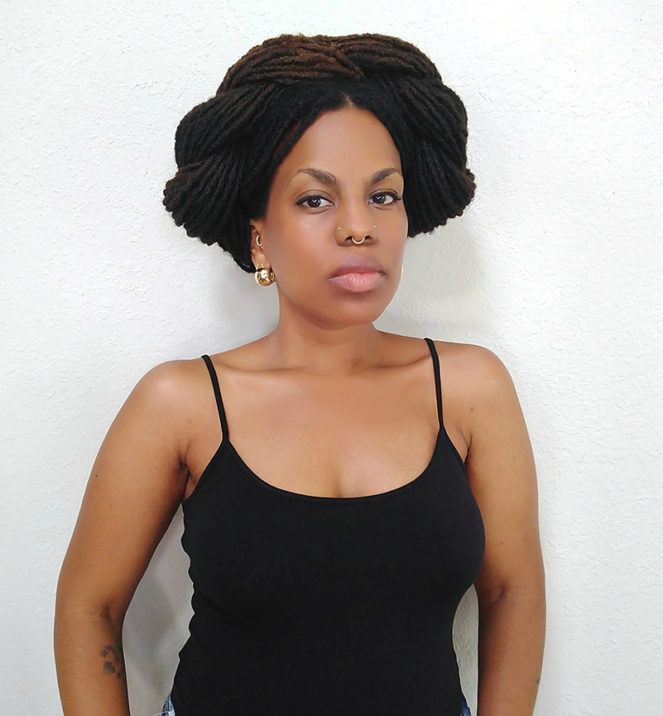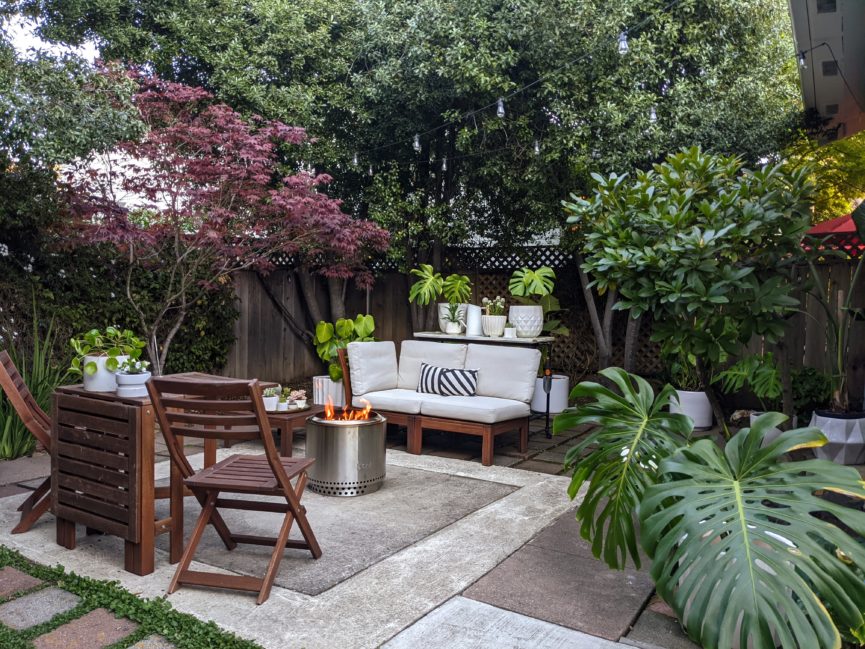Photo by Denise Bayron
Denise Bayron of Bayron Handmade, a self-taught knitwear and fashion designer residing in sunny California, seeks warmth in all environments– whether it be in the lush garden immediately outside the french doors of her tiny home, or in the glow of her Solo Stove Bonfire. We chatted with Denise to learn how elements of nature play a role in her everyday life, as well as in her latest fashions. Read more to find out how Denise puts the “Handmade” in Bayron Handmade.
*interview was conducted via Zoom, statements by Denise Bayron have been interpreted and paraphrased by Solo Stove staff.
Hi, Denise! Tell us more about you and what you do!
My name is Denise Bayron. I am a knitwear designer and sewing patternmaker. I’m also working on writing a book, a design and lifestyle book. It will contain all the crafts: knitting, sewing, crochet, and macrame. The book will include a capsule wardrobe and home decor items. I’ve just published a cable-knit pillow pattern on my website called the #gracepillow.

How long have you been a designer? What started that journey for you?
Under my own brand as Bayron Handmade, I’ve been designing since 2018. That’s when I self-published my first design called the CardiZen. But, I’ve been a maker and a lover of all things handmade my whole life. I learned to crochet when I was four years old. I started without patterns, just making things that came from my heart and my head. I later branched into jewelry design, furniture making, modifying and making my own clothes, even mural painting.
I also worked in the fashion industry for fifteen years. For eight of those years, I worked my way up to be a VP for a fashion, beauty, and lifestyle PR agency.
What sparked your passion for design?
I don’t think there was ever a moment where there was a spark. It’s truly innate, something I can’t control [laughs]. I’ve always been drawn to appreciating art and making beautiful things from scratch. Being able to conceptualize an idea, figure out how to make it, learn the skills necessary to . . . not just do a mediocre job, but to finish it and finish it well. That’s something that’s always been a part of me. I’m not sure there was a moment where I was like, “Oh, I might want to dabble in this” [laughs].
“Moving Forward Wrap” by Denise Bayron
What does it take to create a quality design and make it well?
Oooh, that’s a great question. When designing pieces for the public, you need to know your strengths and your limitations. If you are making something for yourself, it doesn’t matter if it comes out a little wonky. But making things for the public involves surrounding yourself with people who are experts in areas where you are lacking.
For example, I work with an amazing editor. She double-checks my grammar, catches when I add two spaces in between sentences, and makes sure my math works out correctly. I sometimes hire a graphic designer for help with illustrations. It’s important to have a team around you that are not “yes” people, but people that will be honest and say, “That’s great” and “That’s not great.” Those people are important to create a quality design. Find people that are smarter than you and bring them onto your team. That takes humility, though, to realize you need help.
Where do you find inspiration?
When I think back to my first design . . . it was a sweater design, I was going through a yoga teacher training program. That’s a time of introspection and thinking, “What am I doing with my life?” [laughs]. I wanted to wear a cuddly sweater because we sat on the floor as we went through meditations. But I couldn’t find the sweater I wanted. I couldn’t find one at a store or a pattern that I could use to make one. So, I made it. I bought the yarn. I bought the needles. And it worked! I would go out on Saturday mornings, you know, to get coffee or something with a friend, and people would stop me on the street and ask, “Where did you buy your sweater?” I would have that moment inside my head when I was like, “I made it. I made it!” [laughs]. I posted about that moment on Instagram and people, over and over again, would say, “If you write a pattern for that, you can take my money.” That’s when I knew I was going to do this.
Having had a background in the fashion industry, I knew everyone starts somewhere. If my smaller audience, at that time, had faith in me to deliver a pattern that they could successfully reproduce, I knew I could give it a try. I published the design in November 2018. A couple of months later, it was written about in the New Yorker [laughs]. I thought, “I guess that was good. I can do this!” Making a living out of doing something you truly are passionate about is a blessing.
Photo by Denise Bayron
So, you kind of fell into the world of design, right?
Yes, initially. But there was a transition period where I went from a hobbyist, making things just for me, to acquiring the skills and the team I needed to produce designs and patterns that other people could make as well. I “fell” into the concept of becoming a designer, but I certainly had to hustle and rely on the transferable skills I gained from my previous careers to make a business under my own brand.
How do you feel you’ve changed the game in your field?
I feel like knitting and sewing your own clothing was once perceived as “grandma’s work,” you know? I think I bring a modern eye and perspective to a craft that was looked down upon by younger consumers and makers. I strive to bring designs to the market that are timeless.
Another thing I bring to the table is diversity in an industry that was sorely lacking it. I design from my perspective and lived experiences as a woman of color. I am Black Latina or Afro-Latina. My parents are from Puerto Rico. Representation is important in all industries, and I feel grateful when I hear that I make other Black and Brown makers feel seen. I also make a point to hire models of different body sizes so everyone can feel included.
Do you draw a lot of inspiration from nature?
Ab-so-lutely! When it comes to my home or my wardrobe, I’m not a person that wears or lives with bright colors. I feel soothed and calmed by cream tones, whites, browns, and greens. Nature is a big draw in my personal life, as well as in my designs. I like to mix natural fibers to make a sensory experience. With knits, I also use different stitch patterns to make different textures and geometric shapes.
“Wave Of Change Jacket” by Denise Bayron
While we’re on the subject, let’s talk about your tiny home!
YES! So, this is my second tiny house. When I first moved to the Bay area, I rented a really tiny house, smaller than the one I live in now. It was gorgeous! But it was too tiny at 180 sq ft. . There wasn’t even room for an armchair, and sleeping on a twin bed as a grown woman is tough [laughs]. Later on, I moved and landed here. It’s only a little bit bigger than my old house, but with 280 sq ft. I have enough room for a sofa, a bed, and a workspace. In terms of the design of the home, I was looking for a place with a lot of light so I could have all of my plants with me.
Running a textile business requires a lot of supplies: yarn, sewing machines, fabric. So, I needed a home that was small enough to meet my sustainability goals but also big enough to run my business. This house was that perfect sweet spot.
I created “zones.” Right now, I’m in my office zone [laughs]. It’s literally just my desk. I also have a gateleg sewing table in my work zone. When the table is folded down, it only takes up eight inches off the wall. When it’s unfolded, it is the size of a full dining table. I use it for drafting and cutting fabric. I also have a lounge and living space, as well as my bedroom area all in one room.
And then there is this gorgeous garden. The first time I saw it, I knew this was the place for me. The garden is right outside my front door. I can open the french doors and have a smooth transition between indoor and outdoor spaces with plants everywhere.
Photo by Denise Bayron
You’ve posted some pictures of your Solo Stove fire pit in your garden. What does your fire pit add to your space?
I’m going to go with a single word: warmth [laughs]. And I don’t mean literal warmth, although it definitely adds that. I mean, like, “cozy” warmth. The garden has become a gathering place. Which invitation sounds better to you? “Hey, come over and have a cup of tea outside with me?” or “Hey, come over and sit by the fire with me?” Everyone responds “YES!” to the second one [laughs]. When the pandemic began, the only place where I could safely socialize was outside. I really wanted the fire pit so that I could extend the amount of time I spent outside in a day, as well as throughout the seasons. If it’s not raining, I’m outside by the fire in the evening. I love it so much!
Have other people had the same experience when they come over?
My friends specifically tell me, “Hey, I want to come over and have a fire with you.” I’ve practiced making a “top-down” fire so I don’t have to fuss with feeding it. It just goes for hours. My friends and I get to be together by a self-sustaining fire.
I did some research on this wood product called “Bio Blocks” which are made of recycled compressed sawdust. They are inexpensive and fit perfectly inside the Ranger. These blocks burn longer and hotter and than traditional firewood. I feel good about using this sustainable product because wood didn’t have to be harvested for my fire, and I can make a fire for six bucks. It is a win-win.

